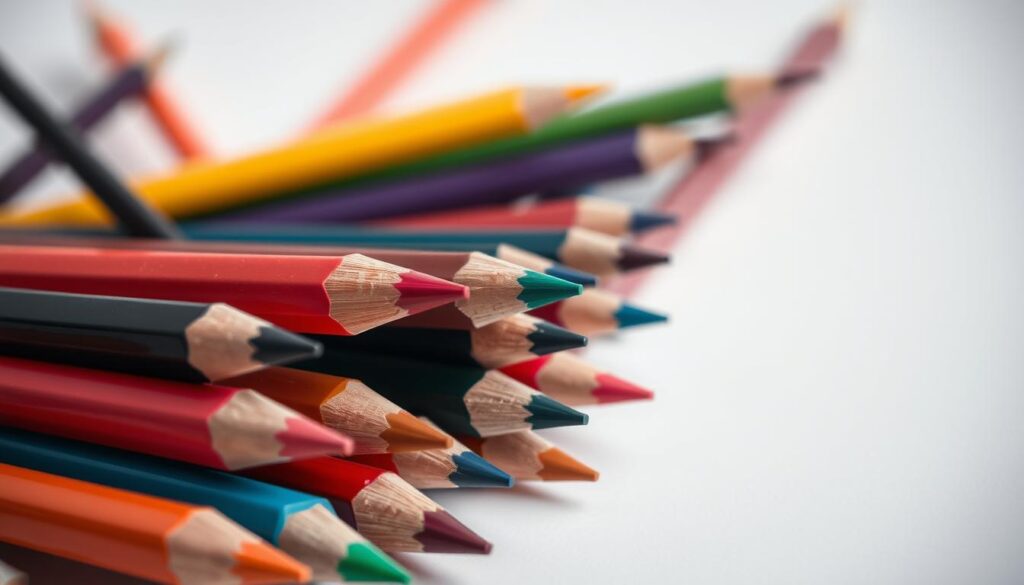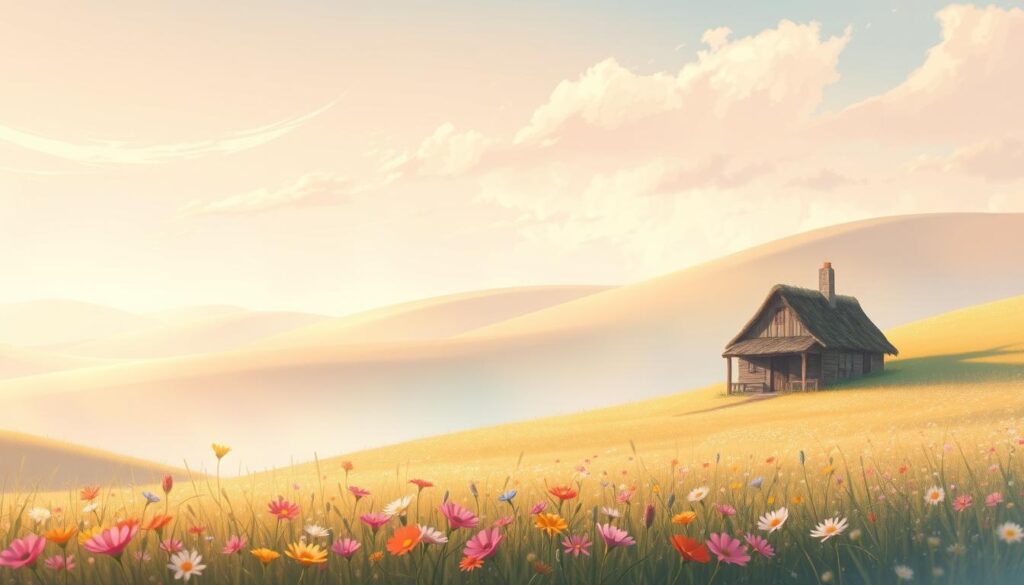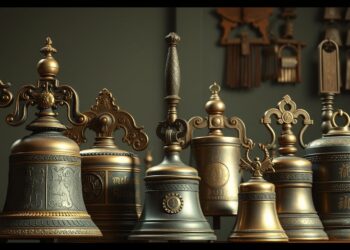Learning coloring techniques is key for artists. It can make their work better and open up new creative paths. With many techniques out there, it’s hard to know where to begin.
Whether you’re new or have been doing art for a while, knowing how to color well is important. By trying out different techniques, you can grow your skills. This lets you bring your artistic ideas to life.
Key Takeaways
- Learn the basics of various coloring techniques
- Understand how to apply different techniques to your art
- Discover how mastering coloring techniques can improve your art
- Explore the different tools and materials needed for each technique
- Develop a systematic approach to learning and practicing coloring techniques
Understanding the Basics of Coloring Techniques
Coloring starts with knowing color theory basics. It’s key to see how colors work together and what feelings they bring up.
What is Coloring?
Coloring means adding colors to a surface with different tools. It’s a way to express yourself and relax. You can use paints, colored pencils, or digital tools.
Learning various coloring techniques and tricks can make your art better. It also makes coloring more fun.
The Importance of Color Theory
Color theory is key in coloring. It teaches how to mix colors and create nice color schemes. It also shows how to use color to show feelings and moods.
Knowing color theory can really help your coloring skills. Let’s look at a simple color theory table:
| Primary Color | Secondary Color | Tertiary Color |
|---|---|---|
| Red | Orange (Red + Yellow) | Red-Orange |
| Blue | Green (Blue + Yellow) | Blue-Green |
| Yellow | Purple (Blue + Red) | Yellow-Green |
Knowing the color wheel and how to mix colors is crucial. It helps you make colors that look good together. By using color theory, your coloring can look amazing.
Watercolor Techniques
Watercolor is known for its transparency and fluidity. It’s great for creating delicate, layered colors. Artists use transparent washes to get soft, subtle hues or vibrant colors.
To get good at watercolor, you need to know a few key techniques. These include wet-on-wet and wet-on-dry methods.
Wet-on-Wet vs. Wet-on-Dry
The wet-on-wet technique means painting wet on wet paper. It makes colors blend smoothly and edges soft. It’s perfect for backgrounds and soft effects.
The wet-on-dry technique paints wet on dry paper. It gives sharp edges and crisp details. It’s great for fine details and textures.
Layering and Glazing
Layering and glazing are key in watercolor. Layering means adding many washes to deepen colors. Each layer must dry before adding the next to keep colors clear.
Glazing adds a transparent layer over existing paint. It makes colors glow and adds depth. It’s great for creating atmosphere.
Learning these techniques lets you explore new ways to paint with watercolor. You can create unique and beautiful works of art.
Acrylic Painting Styles
Acrylic paint is a versatile medium for artists. It lets them try out many techniques and effects. This makes it a favorite among artists who want to explore different styles and get unique results.
Acrylic paint can be used in many ways. You can make thick, textured layers or smooth, blended colors. This flexibility is great for exploring popular coloring styles and techniques. It’s perfect for creative expression.
Thick Textures
The impasto technique uses thick paint layers to create a raised texture. This adds depth and interest to your artwork. It makes the artwork more engaging for viewers.
To get impasto effects, use a palette knife or thick brush. Work fast because acrylic paint dries quickly. You can also mix paint with texture paste or gel to make the texture better.
Smooth Transitions
Blending colors is key in acrylic painting. It merges two or more colors for a smooth transition. This technique adds depth and complexity to your artwork.
To blend colors, use a wet-on-wet technique. Apply wet paint to wet paint. Or, use a blending medium to mix the colors. Remember, work fast because acrylic paint dries fast.
Oil Painting Methods
Oil painting offers many methods like alla prima, glazing, and scumbling. These techniques help artists create different looks. You can get bright colors or textured surfaces.
Learning oil painting adds depth to your art. It makes your work more interesting for viewers. Let’s look at some key methods to improve your art.
Alla Prima Technique
Alla prima means painting wet over wet. It lets you work quickly and freely. This method is great for catching light and making lively paintings.
Benefits of Alla Prima:
- It lets you paint wet-on-wet, saving time
- It boosts creativity and spontaneity
- It brings out bright, vivid colors
Glazing and Scumbling
Glazing uses thin, clear layers for deep colors. Scumbling adds a textured layer over existing paint. Both methods add depth and interest.
Glazing Techniques:
| Technique | Description | Effect |
|---|---|---|
| Layering Transparent Colors | Apply multiple thin layers of transparent paint | Deep, luminous colors |
| Building Up Colors | Gradually build up color intensity | Rich, complex hues |
“The art of glazing is not just about layering colors; it’s about creating a sense of depth and luminosity that draws the viewer in.” –
Scumbling adds texture and interest. It makes your painting more dynamic by mixing old and new colors.
Using these oil painting methods can make your art unique and engaging. They open up new ways to express your creativity.
Markers and Inks
Markers and inks are key for bold lines and fine details in your art. They can make subtle shades or bright, bold lines.
There are many types of markers and inks, each with its own special use. Knowing the differences helps you pick the best tools for your art.
Alcohol-Based vs. Water-Based
Markers and inks can be alcohol-based or water-based. Alcohol-based markers blend well and dry fast, perfect for smooth layers. Water-based inks have bright colors and are easy to use.
| Characteristics | Alcohol-Based | Water-Based |
|---|---|---|
| Blendability | High | Moderate |
| Drying Time | Fast | Variable |
| Color Vibrancy | High | High |
Techniques for Fine Detail
Getting fine details right needs precision and the right methods. Use fine-tip markers or a dip pen for small work. Layering and hatching make detailed, sharp images.
Try different markers and inks to add texture and interest. Learning new coloring techniques opens up more creative ways to express yourself.
Colored Pencils
Colored pencils are great for layering and blending colors. They help create detailed artwork. You can make subtle color changes or textured effects with them.
Burnishing and Layering
Burnishing and layering are key in colored pencil art. Burnishing means applying heavy pressure to mix colors smoothly. Layering lets artists add colors step by step for deep shades.
To burnish, start with a light color and spread it evenly. Then, add a darker shade and press hard to mix. For layering, start with a base color and add layers of different colors, letting each dry before adding the next.
“The key to successful layering is patience. By allowing each layer to dry and building up gradually, you can achieve rich, nuanced colors that add depth to your artwork.”
| Technique | Description | Effect |
|---|---|---|
| Burnishing | Applying heavy pressure to blend colors | Smooth, blended finish |
| Layering | Building up colors gradually | Complex hues and shades |
Using Solvents for Blending
Solvents help blend colored pencil marks. Turpentine and odorless mineral spirits are good solvents. They dissolve colored pencil wax when applied with a brush.
Work in a well-ventilated area when using solvents. Start with a light pencil layer, then blend with a brush and solvent.

Using solvents can create many effects, like watercolor washes. Try different solvents and methods to find new art possibilities.
Digital Coloring Techniques
Digital coloring has changed how artists work with colors. Digital art software lets artists do things they couldn’t before. This includes many effects and textures.
Digital coloring is very flexible. Artists can try new things and fix mistakes easily. This makes creating art more fun and less stressful. We’ll look at some key digital coloring techniques, like software and layering.
Software Options for Digital Coloring
The software you use affects your art a lot. Popular choices are Adobe Photoshop, Clip Studio Paint, and Krita. These programs have tools for managing layers, customizing brushes, and adjusting colors.
Clip Studio Paint is great for comic and manga artists. It’s easy to use but powerful. Knowing what your software can do is important for digital coloring.
Layering in Digital Art
Layering is key in digital coloring. It lets artists build complex images layer by layer. Each layer can be changed separately, giving artists control.
Mastering layering makes digital coloring better. For example, using different layers for parts of your art makes editing easier. It also lets you change things more easily.
Mixed Media Approaches
Mixed media art combines different techniques to create unique pieces. It uses various mediums to make textured artwork. Techniques likecollageandtexturingadd depth and interest.
Trying mixed media lets you find new ways to be creative. It encourages you to innovate and try new things. For example, mixing paint with paper or fabric can create interesting textures.
Combining Different Mediums
Mixed media art is all about mixing mediums. You can mix paint with ink or use pastels with charcoal. The goal is to experiment and find what works best for you.
Some artists mix traditional mediums with digital tools. This mix of old and new can lead to amazing results. Artist Helen Frankenthaler said, “The best art comes from taking risks and challenging norms.”
“The best art is often the result of an artist’s willingness to take risks and challenge conventional norms.”
Creative Texturing Techniques
Texturing is key in mixed media art, making your work feel real. You can use gel medium, modeling paste, or fabric to add texture. Trying different techniques can help you get the look you want.
Here are some common texturing techniques:
| Technique | Description | Materials Needed |
|---|---|---|
| Gel Medium | Adds transparency and texture | Gel medium, palette knife |
| Modeling Paste | Creates thick, heavy textures | Modeling paste, palette knife |
| Collage | Adds layers and interest | Paper, glue, scissors |
Pastel Techniques
Learning pastel techniques can make your art better. Pastels are soft and powdery, great for soft colors. You can blend and layer them for cool textures and effects.
It’s key to know the difference between soft and hard pastels. Soft pastels are more colorful and blend well. Hard pastels are firmer and better for details.
Soft vs. Hard Pastels
Soft pastels are perfect for smooth backgrounds and soft color changes. They’re very colorful, great for layering. Hard pastels are better for detailed work and fine lines.
| Characteristics | Soft Pastels | Hard Pastels |
|---|---|---|
| Pigmentation | Highly pigmented | Less pigmented |
| Blending | Blends easily | Blends with more effort |
| Usage | Ideal for backgrounds and smooth transitions | Better for detailed work and fine lines |
Blending Techniques
Blending is key with pastels. It helps mix colors smoothly and create soft changes. You can blend with your fingers, a blending stump, or a soft brush.
Tips for effective blending:
- Start with light layers and gradually build up.
- Use a gentle touch to avoid over-blending.
- Experiment with different blending tools to achieve unique effects.

Mastering pastel techniques, like using soft and hard pastels and blending, can enhance your art. Pastels are versatile for landscapes, portraits, or abstracts. They let you express your creativity in many ways.
Understanding Color Palettes
Learning about color palettes is key for artists. It’s about picking colors that go well together. Techniques like harmonious palettes and monochromatic or complementary colors help artists create unique looks.
The choice of popular coloring styles greatly affects an artwork’s mood and look. Knowing how to pick effective color palettes can make your art more appealing.
Creating Harmonious Palettes
Harmonious palettes are about picking colors that look good together. Using colors next to each other on the color wheel, called analogous colors, is one way. This makes a palette that’s soothing and cohesive.
Another method is using colors that are far apart on the color wheel, called triadic colors. This makes a palette that’s balanced and bright. Trying out different colors can help you find the right one for your art.
Monochromatic vs. Complementary Colors
Monochromatic colors use different shades of the same color. This makes a palette that’s cohesive and harmonious. Monochromatic palettes are great for creating unity in your art.
Complementary colors are pairs of colors that are opposite each other on the color wheel. They add contrast and interest to your art. But, it’s important to balance them right to avoid too much.
Knowing the difference between monochromatic and complementary colors opens up more coloring options. It lets you try out different popular coloring styles. By using these techniques, you can make your art more striking and find your own artistic voice.
Developing Your Unique Style
To make artwork that shows your true voice, you must find your unique style. This means trying different coloring ways and seeing how they shape your art.
Experimentation with Techniques
Trying out many coloring methods is key to finding your style. Layering and blending help artists get special textures and looks. Learning these can make your art pop.
Layering means adding color layers to get a certain look. You can use acrylics, oils, or digital tools. Blending mixes colors for smooth changes or new shades. Both add depth and interest to your art.
| Technique | Description | Mediums |
|---|---|---|
| Layering | Applying multiple layers of color | Acrylics, Oils, Digital |
| Blending | Merging colors for smooth transitions | Acrylics, Oils, Colored Pencils |
Finding Your Signature Palette
Your signature palette is a big part of your style. It’s about picking colors that match your art vision and using them often. To find it, try different color mixes and see how they change your art’s feel.
Color theory helps make a good palette. Knowing how colors work together helps choose the right ones. You might like a single color scheme for unity or contrasting colors for drama.
By trying new techniques and finding your color palette, you can create a style that makes you stand out. Remember, finding your art identity is a journey. It’s okay to change and grow your style as you go.
The Role of Lighting in Coloring
Lighting is very important in coloring. It changes how colors look in your art. By using different lights, you can make colors pop and look deeper.
Natural vs. Artificial Light Sources
The kind of light you use changes how colors look. Natural light shows true colors, but artificial light can change them. Artists mix both to get the look they want.
Mastering Shadow and Highlight Techniques
Shadows and highlights make art look real and interesting. Learning to control these adds depth and excitement to your colors.
Keep exploring coloring techniques and trends. Lighting is key to making your art come alive. Use natural and artificial light well, and play with shadows and highlights. This will take your coloring to the next level.



















